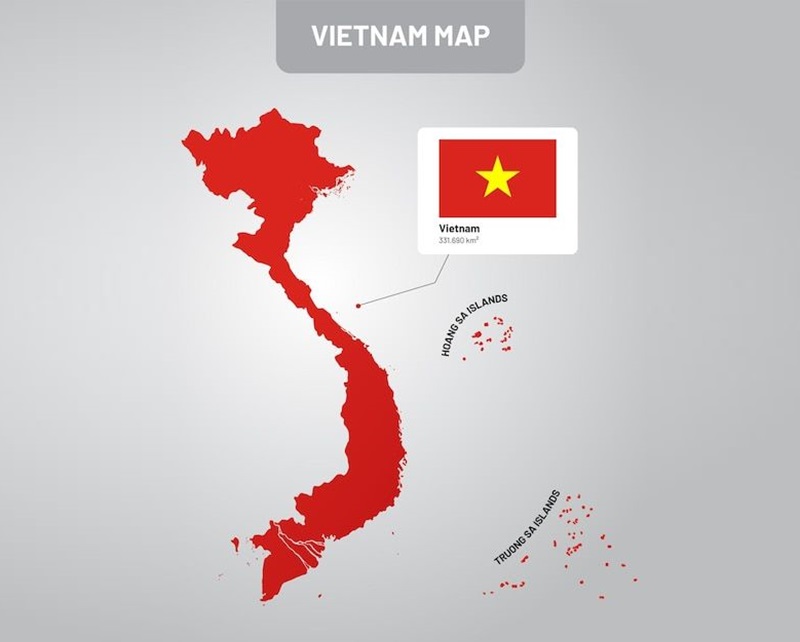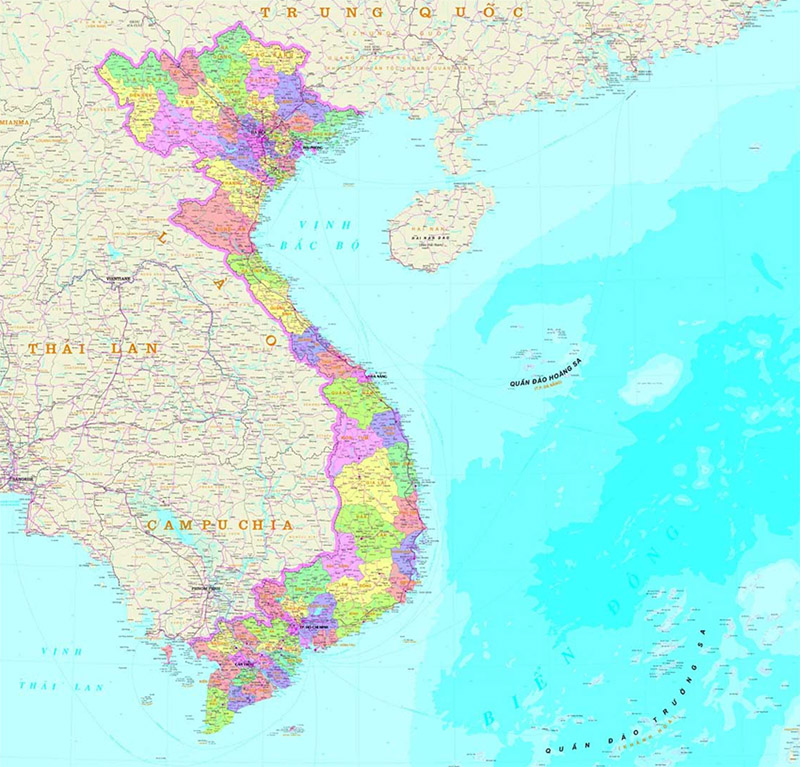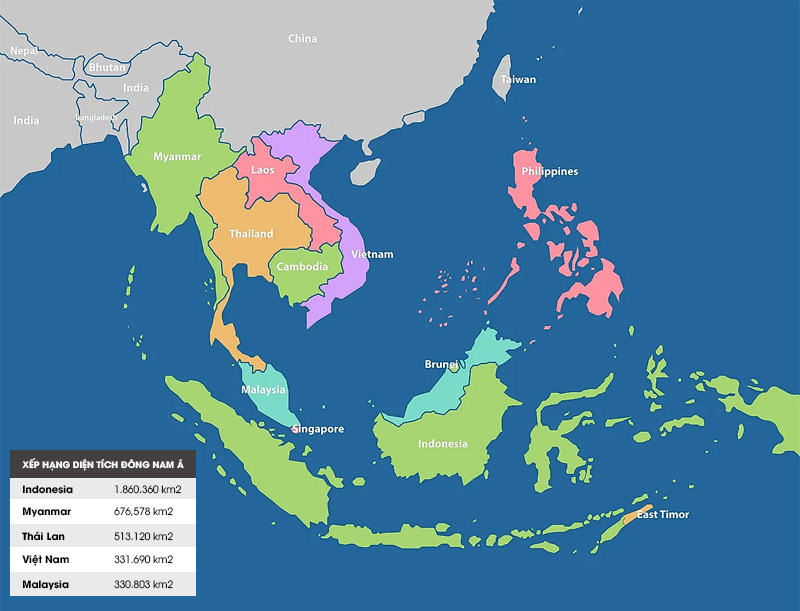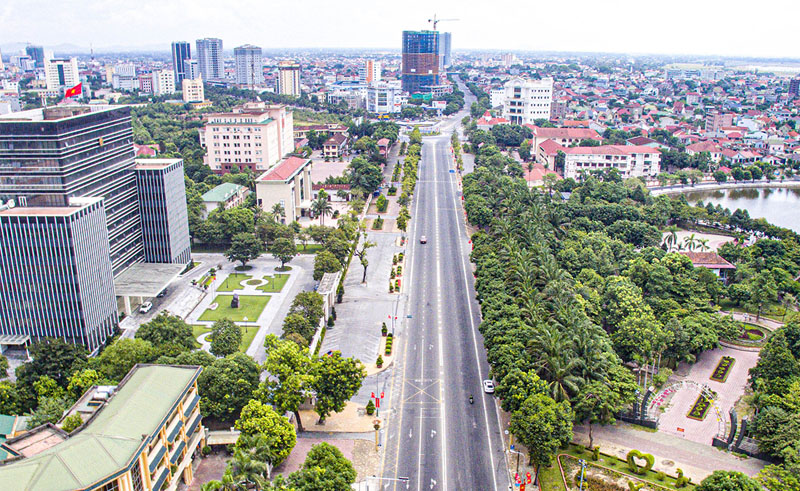Vietnam’s Land Area: Facts, Figures, and Global Comparison

Located in the heart of Southeast Asia, Vietnam is widely recognized by the international community for its rich historical and cultural traditions, hospitable people and numerous stunning landscapes. The country’s vast area, coupled with its advantageous geographic location, provides Vietnam with significant potential for economic and tourism development. So, what is the total land area of Vietnam? How does Vietnam rank globally in terms of land area?
Table of Contents
1. What is the area of Vietnam’s territory?
According to the latest data, Vietnam’s area is 331,690 km², ranking 66th in the world in terms of area. Vietnam has a land border of 4,639 km long, bordering the Gulf of Thailand, the Gulf of Tonkin, the East Sea, China, Laos and Cambodia.
Vietnam’s territory is about 327,480 km2 of land area and more than 4,500 km2 of internal waters (including water areas and waterways in the mainland measured from the baseline inwards) with more than 4,800 islands and reefs. The entire area of Vietnam includes the area of the two archipelagos Hoang Sa and Truong Sa that Vietnam claims sovereignty over.

Vietnam is one of the countries in Southeast Asia, located on the Indochina peninsula, along the Pacific coast. Vietnam’s mainland is S-shaped, stretching from latitude 23o23′ North to 8o27′ North, with a land border of 4,639 km long and a coastline of 3,260 km. Geographic locations on the map are adjacent to the following areas:
- East sea bordering the east
- The West borders Laos and Cambodia
- The North borders China
The widest area on the mainland is about 500 km, while the narrowest area is only about 50 km. Other regions of our country including internal waters, territorial waters, exclusive economic zones and continental shelves also record an area three times larger than the land area (about 1 million square kilometers).
2. What is Vietnam’s largest area in the world?
Vietnam’s area is 331,690 km2, ranked 66th in the world, currently ranked 19th in terms of territorial area in Asia. In Southeast Asia, Vietnam is ranked 4th in terms of territorial area, behind Indonesia (1,472,639 km2), Myanmar (676,578 km2) and Thailand (513,120 km2).
Although it belongs to the group of countries with a medium area, Vietnam stands out with its terrain diversity. From high mountains, midlands to plains and coastlines, all create a rich natural picture for the country.

Vietnam has the 66th largest area in the world, but its population is in the top 15 in the population rankings of countries and territories. According to statistics from the United Nations as of January 2024, Vietnam’s population is estimated at 99,240,587 people (accounting for about 1.23% of the world’s population).
3. Area of 63 provinces and cities in Vietnam
On a total area of 331,690 km2, Vietnam’s territory is divided into 63 provinces and cities with diverse areas as follows:
| No. | Province/City | Area (km²) | Population (people) | Population density (people/km2) |
| 1 | An Giang | 3.536,7 | 1.864.651 | 540 |
| 2 | Ba Ria – Vung Tau | 1.980,8 | 1.181.302 | 580 |
| 3 | Bac Lieu | 2.669 | 917.734 | 340 |
| 4 | Bac Giang | 3.851,4 | 1.858.540 | 468 |
| 5 | Bac Kan | 4.860 | 318.083 | 65 |
| 6 | Bac Ninh | 822,7 | 1.450.518 | 1.664 |
| 7 | Ben Tre | 2.394,6 | 1.295.067 | 538 |
| 8 | Binh Duong | 2.694,7 | 2.678.220 | 900 |
| 9 | Binh Dinh | 6.066,2 | 1.487.009 | 245 |
| 10 | Binh Phuoc | 6.877 | 1.020.839 | 145 |
| 11 | Binh Thuan | 7.812,8 | 1.243.977 | 158 |
| 12 | Ca Mau | 5.294,8 | 1.191.999 | 226 |
| 13 | Cao Bang | 6.700,3 | 535.098 | 79 |
| 14 | Can Tho | 1.439,2 | 1.244.736 | 858 |
| 15 | Da Nang | 1.284,9 | 1.191.381 | 883 |
| 16 | Dak Lak | 13.030,5 | 1.897.710 | 143 |
| 17 | Dak Nong | 6.509,3 | 652.766 | 96 |
| 18 | Dien Bien | 9.541 | 623.295 | 63 |
| 19 | Dong Nai | 5.905,7 | 3.236.248 | 524 |
| 20 | Dong Thap | 3.383,8 | 1.586.438 | 473 |
| 21 | Gia Lai | 15.510,8 | 1.566.882 | 98 |
| 22 | Ha Giang | 7.929,5 | 883.388 | 108 |
| 23 | Ha Nam | 860,9 | 867.258 | 991 |
| 24 | Ha Noi | 3.358,9 | 8.418.883 | 2.398 |
| 25 | Ha Tinh | 5.990,7 | 1.301.601 | 215 |
| 26 | Hai Duong | 1.668,2 | 1.932.090 | 1.135 |
| 27 | Hai Phong | 1.561,8 | 2.069.110 | 1.332 |
| 28 | Hau Giang | 1.621,8 | 728.255 | 452 |
| 29 | Hoa Binh | 4.591 | 868.623 | 186 |
| 30 | Ho Chi Minh | 2.061 | 9.411.805 | 1.347 |
| 31 | Hung Yen | 930,2 | 1.279.308 | 240 |
| 32 | Khanh Hoa | 5.137,8 | 1.246.358 | 271 |
| 33 | Kien Giang | 6.348,8 | 1.730.117 | 56 |
| 34 | Kon Tum | 9.674,2 | 565.685 | 51 |
| 35 | Lai Chau | 9.068,8 | 480.588 | 94 |
| 36 | Lang Son | 8.310,2 | 791.872 | 115 |
| 37 | Lao Cai | 6.364 | 756.083 | 133 |
| 38 | Lam Dong | 9.783,2 | 1.319.952 | 376 |
| 39 | Long An | 4.490,2 | 1.744.138 | 1.067 |
| 40 | Nam Dinh | 1.668 | 1.771.000 | 202 |
| 41 | Nghe An | 1.6493,7 | 3.417.809 | 708 |
| 42 | Ninh Binh | 1.387 | 1.000.093 | 176 |
| 43 | Ninh Thuan | 3.355,3 | 595.698 | 414 |
| 44 | Phu Tho | 3.534,6 | 1.495.116 | 191 |
| 45 | Phu Yen | 5.023,4 | 875.127 | 111 |
| 46 | Quang Binh | 8.065,3 | 905.895 | 141 |
| 47 | Quang Nam | 10.574,7 | 1.510.960 | 240 |
| 48 | Quang Ngai | 5.135,2 | 1.234.704 | 214 |
| 49 | Quang Ninh | 6.177,7 | 1.358.490 | 133 |
| 50 | Quang Tri | 4.739,8 | 639.414 | 362 |
| 51 | Soc Trang | 3.311,8 | 1.181.835 | 88 |
| 52 | Son La | 14.123,5 | 1.286.068 | 289 |
| 53 | Tay Ninh | 4.041,4 | 1.190.852 | 1.185 |
| 54 | Thai Binh | 1.570,5 | 1.876.579 | 364 |
| 55 | Thai Nguyen | 3.536,4 | 1.322.235 | 392 |
| 56 | Thanh Hoa | 11.114,7 | 3.690.022 | 4.363 |
| 57 | Thua Thien Hue | 5.048,2 | 1.137.045 | 224 |
| 58 | Tien Giang | 2.510,5 | 1.783.165 | 703 |
| 59 | Tra Vinh | 2.358,2 | 1.010.404 | 428 |
| 60 | Tuyen Quang | 5.867,9 | 797.392 | 134 |
| 61 | Vinh Long | 1.475 | 1.022.408 | 693 |
| 62 | Vinh Phuc | 12.35,2 | 1.184.074 | 934 |
| 63 | Yen Bai | 6.887,7 | 838.181 | 119 |
Among the 63 provinces and cities in Vietnam, Nghe An is the province with the largest area with an area of about 16,493.7 km2 (accounting for nearly 36% of the total area of the country). Immediately following are the following provinces: Gia Lai (15,510.8 km2), Son La (14,123.5 km2), Dak Lak (13,030.5 km2), Thanh Hoa (11,114.7 km2), Quang Nam (10,574, 7 km2).

Hopefully through the above article of Maison Office, you have received complete and accurate information about the area of Vietnam. The large area and favorable geographical location are one of the important factors contributing to creating a unique identity for Vietnam, a culturally diverse country and rich in natural resources. This brings Vietnam great potential for economic, cultural and social development.





